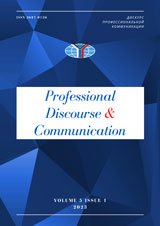
Professional Discourse & Communication is an international peer-reviewed open-access quarterly online journal dedicated to discussing various theoretical and applied problems of professional communication. Its articles provide researchers and practitioners with the most up-to-date, comprehensive and important research, paying specific attention to modern linguistic approaches to professional discourse and institutional communication as well as practical aspects of teaching methodology as related to the language of particular professional spheres.
Professional Discourse & Communication publishes substantial research papers and empirical studies, discussion notes, critical overviews, reviews of books and conferences. All publications are free of charge. The journal accepts papers in two languages: English and Russian.
Professional Discourse & Communication specifically addresses readers in any field of professional communication (business, legal, diplomatic, economic, political, academic, and any other professional sphere) who are interested in qualitative discourse analysis, as well as scholars in discourse studies, functional linguistics, pragmatics, semiotics, rhetoric, linguosynergetics, sociolinguistics, cognitive linguistics, stylistics, cross-cultural communication, culture studies, country studies, second language acquisition and teaching methodology, and related fields.
PDC is included in the List of journals (K2) recommended by the Higher Attestation Commission of the Russian Federation (VAK) in the following fields:
5.9.6. Languages of foreign countries (Philological Sciences)
5.9.8. Theoretical, Applied and Comparative Linguistics (Philological Sciences).
Professional Discourse & Communication embraces a global perspective, and we are delighted to welcome contributions from researchers worldwide. Our international author base includes researchers from Algeria, Azerbaijan, Belarus, Brazil, China, Croatia, Ethiopia, Georgia, Germany, Ghana, India, Indonesia, Iran, Kenya, Nigeria, Philippines, Russia, Saudi Arabia, Slovakia, Tanzania, Ukraine, United Kingdom, and United States. This diverse authorship underscores our dedication to promoting a truly global dialogue in our field and sharing cutting-edge research from across the globe.
At Professional Discourse & Communication, we believe that a diverse Editorial Board is crucial for developing a truly international exchange of knowledge. Our board embodies this belief, bringing together leading experts from different geographical and academic backgrounds. Representing institutions in Armenia, China, Finland, Hong Kong, Iran, Kenya, Russia, Serbia, Spain, and the United States, our editors contribute a wealth of perspectives and expertise to the journal.
Main information about PDC:
Editor-in-Chief | Prof. Dmitry S. Khramchenko |
Publisher | Moscow State Institute of International Relations (MGIMO University) |
Country of publication | Russian Federation |
Founded in | 2019 |
ISSN | 2687-0126 |
Format | Platinum Open Access |
Indexation | DOAJ, Russian Index of Science Citation, Ulrich's Web, Google Scholar |
Licensing | |
Publication Frequency | Quarterly |
Publication Dates | March, June, September, December |
Peer Review | Double blind peer review |
Language | English, Russian |
Type of Journal | Academic/Scholarly |
Scope | Language & linguistics, Education |
APC | No Article Processing Charges apply |
Fees | All publications are free of charge |
Review Time | Four Weeks Approximately |
Contact & Submission |


























